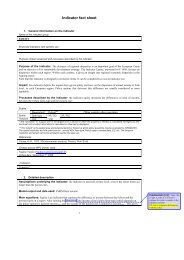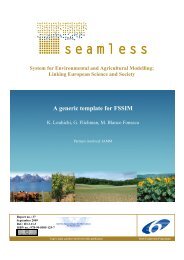Farming Systems Design 2007 - International Environmental ...
Farming Systems Design 2007 - International Environmental ...
Farming Systems Design 2007 - International Environmental ...
You also want an ePaper? Increase the reach of your titles
YUMPU automatically turns print PDFs into web optimized ePapers that Google loves.
<strong>Farming</strong> <strong>Systems</strong> <strong>Design</strong> <strong>2007</strong><br />
Field-farm scale design and improvement<br />
1). The percent consumption of vegetables and fruits were 45 and 42% of production only. The<br />
supply of nutrients from fruits and vegetables of the tested model surplus the need for most of the<br />
wanting essential nutrients like Vitamin A, C, calcium and iron-previously deficient in the diet. An<br />
Ample amount of Vitamin B1, B2, protein and energy were also obtained from the supplied food of<br />
the model (Table 2).<br />
Table 1. Av. yield of vegetable, fruits, gross return, disposal pattern and cash income of integrated model.<br />
Yield family -1 Return Disposal of the produce family -1 (kg)<br />
Crops<br />
(kg) family -1<br />
(kg)<br />
Consumption Distribution Sale Cash income<br />
(Tk.)<br />
Vegetables 746 2,832 337 (45%) 105 (15%) 304 (41%) 1,143<br />
Mean family -1 day -1 2.04 8 0.92 0.29 0.83 3.13<br />
Fruits 810 8,664 334 (42%) 238 (29%) 238 (29%) 1,979<br />
Mean family -1 day -1 2.22 24 0.92 0.80 0.65 5.42<br />
Grand total (Veg. + Fruits) 1,556 11,496 671(43%) 343(22%) 542(35%) 3,122<br />
G. Mean family -1 day -1 4.26 (710 g) 31.5 1.84 0.94 1.48 8.55<br />
Total cost for the model(Tk.) - 350 - - - -<br />
Benefit cost ratio - 32.85 - - - -<br />
Table 2. Average yield of vegetables, fruits and nutrient contents of integrated model.<br />
Yield<br />
Content of nutrients<br />
Crops<br />
Carotene Vit.C Vit.B-1 Vit.B-2 Calcium Iron Energy Protein<br />
(kg) (μgm) (μgm) (μgm) (μgm) (μgm) (μgm) (kcal) (gm)<br />
Vegetables 746 14,959 320,298 1306 655 1409,927 113,322 767,412 16,861<br />
Mean family -1 day -1 2.04 41 878 4 2 3,863 310 2,102 46<br />
Fruits 810 29,597 187,588 404.9 318 82,117 21,864 397,511 6,164<br />
Mean family -1 day -1 2.22 81 514 1.11 0.87 225 60 1,089 16.89<br />
Total from both resources 4,026 122 1,392 5.11 2.87 4,088 370 3,191 6.89<br />
Daily needs family -1 * 1.5 10 260 7.0 6.3 3,000 145 14,100 284<br />
% of requirement supplied 284 1,220 535 73 46 136 255 23 22<br />
*Estimated from data provided by Haque (1985) for 6 members family<br />
Income generation and poverty reduction<br />
The average gross return was obtained Tk. 11496 per family from the model with a very little cash<br />
investment (Tk. 350 year -1 , 1 US$ = Taka 68). The average BCR on cash cost basis was over<br />
32.85. This cash is generating round the year enabling the poor cooperators to meet up immediate<br />
family needs like purchase of edible oil, lighting fuel (kerosene), pulse, salt and spices despite<br />
borrow money with high interest from land lord. Opportunity created for employment of underused<br />
women and children labors in the homestead activities. Sufficient amount of nutrients supplying<br />
from the food of the model, which is helped in crossing poverty level (23% energy, Table 2).<br />
Empowerment of women and gender equity<br />
The women members were actively participated in the program and involved in majority of the<br />
gardening activities, earned 24% of family income, and participated in different group activities,<br />
trainings and field days. Even 40% women alone made decision in different activities (data not<br />
shown). This empowerment enabled women in attaining gender equity and increase prestige in the<br />
family as well as in the society.<br />
Conclusions<br />
The vegetable production model of Pabna is a holistic and intensive system produced highest<br />
nutrients and vegetable compared to any such model tested for far in the country. It is based on<br />
traditional and natural systems, which is easily transferable in most of the under developed<br />
countries. Only change of crop species and varieties may be required to fit in the model.<br />
References<br />
Akhtar et al., Existing homestead production and utilization systems. Annual report 2000. OFRD, BARI,<br />
ARS, Pabna. Pp. 7-18.<br />
BARC, <strong>Farming</strong> <strong>Systems</strong> Agribusiness Newsletter. 1990. Vol.1 (2). Bangladesh Agril. Res. Council, Dhaka.<br />
Islam et al., Homestead vegetable production. A means of household food security and nutrition for marginal<br />
farmers in northwest Bangladesh. 1996. Symposium proceedings. 14 th <strong>International</strong> Symposium on<br />
Sustainable <strong>Farming</strong> <strong>Systems</strong>, 11-16 Nov.,1996, Colombo, Srilanka, pp. Twi/81-89.<br />
Mahmud, S.A., Introductory: Cultivation and nutritional identity of fruits and vegetables.1985. Dept. of<br />
Agricultural Extension, Khamarbari, Dhaka.<br />
Rashid, M.M., Shobji bijyan. Second edition. 1999. Rashid Publishing House. 98, DOHS, Dhaka. pp.43-51.<br />
- 16 -




